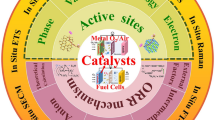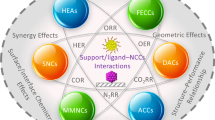Abstract
Oxide reducibility is an important property in catalysis by metal-oxides. The reducibility of an oxide can be substantially modified when an interface is created between the oxide and a metal. Here we discuss two types of interfaces. One consists of gold nanoparticles deposited on anatase TiO2 or tetragonal ZrO2 (101) surfaces; these are traditional direct catalysts (metal deposited on an oxide). The second example consists of a metal support, Pt or a Pt3Zr alloy, where a ZrO2 nanofilm is deposited; this is representative of an inverse catalyst (oxide on metal). We designed models of these systems and analyzed by means of first principle calculations a key descriptor of the oxide reducibility, the cost of formation of an oxygen vacancy. We show that this cost is dramatically reduced when the oxide is interfaced with the metal. The effect on catalytic reactions is analyzed by computing the energy profiles for the CO oxidation reaction on Au/TiO2 and Au/ZrO2 model catalysts. Despite the very different nature of the two oxide supports, reducible for TiO2 and non-reducible for ZrO2, the same Au-assisted Mars–van Krevelen mechanism is found, with similar barriers.
Similar content being viewed by others
References
Wachs IE (2005) Recent conceptual advances in the catalysis science of mixed metal oxide catalytic materials. Catal Today 100:79–94
Grasselli RK (2002) Fundamental principles of selective heterogeneous oxidation catalysis. Topics Catal 21:79–88
Mars P, Van Krevelen DW (1954) Oxidations carried out by means of vanadium oxide catalysts. Chem Eng Sci 3:41–59
Helali Z, Jedidi A, Syzgantseva OA, Calatayud M, Minot C (2017) Scaling reducibility of metal oxides. Theor Chem Acc 136:100
Pham TN, Sooknoi T, Crossley SP, Resasco DE (2013) Ketonization of carboxylic acids: mechanisms, catalysts, and implications for biomass conversion. ACS Catal 3:2456–2473
Tosoni S, Chen HYT, Puigdollers AR, Pacchioni G (2018) TiO2 and ZrO2 in biomass conversion: why catalyst reduction helps. Philos Trans R Soc A 376:20170056
Tosoni S, Pacchioni G (2016) Acetic acid ketonization on tetragonal zirconia: role of surface reduction. J Catal 344:465–473
Chen HJ, Pacchioni G (2016) Role of oxide reducibility in the deoxygenation of phenol on rutheniun clusters supported on the anatase TiO2 (101) surface. ChemCatChem 8:2492–2499
Puigdollers AR, Illas F, Pacchioni G (2016) Structure and properties of zirconia nanoparticles from density functional theory calculations. J Phys Chem C 120:4392–4402
Ruiz Puigdollers A, Tosoni S, Pacchioni G (2016) Turning a nonreducible into a reducible oxide via nanostructuring: opposite behavior of bulk ZrO2 and ZrO2 nanoparticles toward H2 adsorption. J Phys Chem C 120:15329–15337
Albanese E, Ruiz Puigdollers A, Pacchioni G (2018) Theory of ferromagnetism in reduced ZrO2–x nanoparticles. ACS Omega 3:5301–5307
Rahman MA, Rout S, Thomas JP, McGillivray D, Leung KT (2016) Defect-rich dopant-free ZrO2 nanostructures with superior dilute ferromagnetic semiconductor properties. J Am Chem Soc 138:11896–11906
Ruiz Puigdollers A, Schlexer P, Tosoni S, Pacchioni G (2017) Increasing oxide reducibility: the role of metal/oxide interfaces in the formation of oxygen vacancies. ACS Catal 7:6493–6513
Widmann D, Behm RJ (2011) Active oxygen on a Au/TiO2 catalyst—formation, stability and CO oxidation activity. Angew Chem Int Ed 50:10241–10245
Schlexer P, Widmann D, Behm RJ, Pacchioni G (2018) CO oxidation on a Au/TiO2 nanoparticle catalyst via the Au-assisted Mars-van-Krevelen mechanism. ACS Catal 8:6513–6525
Puigdollers AR, Pacchioni G (2017) CO oxidation on Au nanoparticles supported on ZrO2: role of metal/oxide interface and oxide reducibility. ChemCatChem 9:1119–1127
Puigdollers AR, Pacchioni G (2017) Reducibility of ZrO2/Pt3Zr and ZrO2/Pt 2D films compared to bulk zirconia: a DFT + U study of oxygen removal and H2 adsorption. Nanoscale 9:6866–6876
Kresse G, Hafner J (1993) Ab initio molecular dynamics for liquid metals. Phys Rev B 47:558–561
Kresse G, Furthmüller J (1996) Efficient iterative schemes for ab initio total-energy calculations using a plane-wave basis set. Phys Rev B 54:11169–11186
Perdew JP, Burke K, Ernzerhof M (1996) Generalized gradient approximation made simple. Phys Rev Lett 77:3865–3868
Dudarev SL, Botton GA, Savrasov SY, Humphreys CJ, Sutton AP (1998) Electron energy loss spectra and the structural stability of nickel oxide: an LSDA + U study. Phys Rev B 57:1505–1509
Blöchl PE (1994) Projector augmented-wave method. Phys Rev B 50:17953–17979
Grimme S (2006) Semiempirical GGA-type density functional constructed with a long-range dispersion correction. J Comput Chem 27:1787–1799
Tosoni S, Sauer J (2010) Accurate quantum chemical energies for the interaction of hydrocarbons with oxide surfaces: CH4/MgO (001). Phys Chem Chem Phys 12:14330–14340
Sanville E, Kenny SD, Smith R, Henkelman G (2007) Improved grid-based algorithm for bader charge allocation. J Comput Chem 28:899–908
Henkelman G, Jónsson H (2000) Improved tangent estimate in the nudged elastic band method for finding minimum energy paths and saddle points. J Chem Phys 113:9978–9986
Predel B (1998) Pt-Zr (platinum-zirconium). Springer materials—the Landbolt–Börnstein database. Springer, Berlin. https://doi.org/10.1007/10542753_2542
Haynes MM (2015), CRC handbook of chemistry and physics, 96th edn. CRC Press, Boca Raton
Haruta M, Daté M (2001) Advances in the catalysis of Au nanoparticles. Appl Catal A 222:427–437
Hashmi ASK, Hutchings GJ (2006) Gold catalysis. Angew Chem Int Ed 45:7896–7936
Remediakis IN, Lopez N, Nørskov JK (2005) CO oxidation on rutile-supported Au nanoparticles. Angew Chem 117:1858–1860
Widmann D, Behm RJ (2014) Activation of molecular oxygen and the nature of the active oxygen species for CO oxidation on oxide supported Au catalysts. Acc Chem Res 47:740–749
Kotobuki M, Leppelt R, Hansgen D, Widmann D, Behm RJ (2009) Reactive oxygen on a Au/TiO2 supported catalyst. J Catal 264:67–76
Widmann D, Liu Y, Schüth F, Behm RJ (2010) Support cffects in the au catalyzed CO oxidation—correlation between activity, oxygen storage capacity and support reducibility. J Catal 276:292–305
Widmann D, Krautsieder A, Walther P, Brückner A, Behm RJ (2016) How temperature affects the mechanism of CO oxidation on Au/TiO2: a combined EPR and TAP reactor study of the reactive removal of TiO2 surface lattice oxygen in Au/TiO2 by CO. ACS Catal 6:5005–5011
Saavedra J, Doan HA, Pursell CJ, Grabow LC, Chandler BD (2014) The Critical role of water at the gold-titania interface in catalytic CO oxidation. Science 345:1599–1602
Daté M, Haruta M (2001) Moisture effect on CO oxidation over Au/TiO2 catalyst. J Catal 201:221–224
Gionco C, Paganini MC, Giamello E, Burgess R, Di Valentin C, Pacchioni G (2013) Paramagnetic defects in polycrystalline zirconia: an EPR and DFT study. Chem Mater 25:2243–2253
Gerosa M, Bottani CE, Caramella L, Onida G, Di Valentin C, Pacchioni G (2015) Defect calculations in semiconductors through a dielectric-dependent hybrid DFT functional: the case of oxygen vacancies in metal oxides. J Chem Phys 143:134702–134713
Giordano L, Pacchioni G (2011) Oxide films at the nanoscale: new structures, new functions, and new materials. Acc Chem Res 44:1244–1252
Kozlov SM, Demiroglu I, Neyman KM, Bromley ST (2015) Reduced ceria nanofilms from structure prediction. Nanoscale 7:4361–4366
Zhang Y, Giordano L, Pacchioni G, Vittadini A, Sedona F, Finetti P, Granozzi G (2007) The structure of a stoichiometric TiO2 nanophase on Pt (111). Surf Sci 601:3488–3496
Pacchioni G (2012) Two-dimensional oxides: multifunctional materials for advanced technologies. Chem Eur J 18:10144–10158
Antlanger M, Mayr-Schmölzer W, Pavelec J, Mittendorfer F, Redinger J, Varga P, Diebold U, Schmid M (2012) Pt3Zr (0001): a substrate for growing well-ordered ultrathin zirconia films by oxidation. Phys Rev B 86:035451
Li H, Choi JIJ, Mayr-Schmölzer W, Weilach C, Rameshan C, Mittendorfer, Redinger J, Schmidt M, Rupprechter G (2015) Growth of an ultrathin zirconia film on Pt3Zr examined by high-resolution X-ray photoelectron spectroscopy, temperature-programmed desorption, scanning tunneling microscopy, and density functional theory. J Phys Chem C 119:2462–2470
Napetschnig E, Schmid M, Varga P (2008) Ultrathin alumina film on Cu-9 at% Al (111). Surf Sci 602:1750–1756
Maurice V, Salmeron M, Somorjai GA (1990) The epitaxial growth of zirconium oxide thin films on Pt (111) single crystal surfaces. Surf Sci 237:116–126
Meinel K, Eichler A, Förster S, Schindler KM, Neddermeyer H, Widdra W (2006) Surface and interface structures of epitaxial ZrO2 films on Pt (111): experiment and density-functional theory calculations. Phys Rev B 74:235444
Hume-Rothery W (1968) The Engel–Brewer theories of metals and alloys. Prog Mat Sci 13:229–265
Pacchioni G (2000) Quantum chemistry of oxide surfaces: from CO chemisorption to the identification of the structure and nature of point defects on MgO. Surf Rev Lett 7:277–306
Acknowledgements
The work has been supported by the European Community’s Seventh Program (FP7 Nanosciences, Nanotechnologies, Materials and new Production Technologies) FP7/2007–2013 under Grant Agreement No. 607417—European Marie Curie Network CATSENSE, and by the Italian MIUR through the PRIN Project (Ministero dell’Istruzione, dell’Università e della Ricerca) 2015K7FZLH SMARTNESS “Solar driven chemistry: new materials for photo- and electro-catalysis”.
Author information
Authors and Affiliations
Corresponding author
Rights and permissions
About this article
Cite this article
Schlexer, P., Ruiz Puigdollers, A. & Pacchioni, G. Role of Metal/Oxide Interfaces in Enhancing the Local Oxide Reducibility. Top Catal 62, 1192–1201 (2019). https://doi.org/10.1007/s11244-018-1056-5
Published:
Issue Date:
DOI: https://doi.org/10.1007/s11244-018-1056-5












